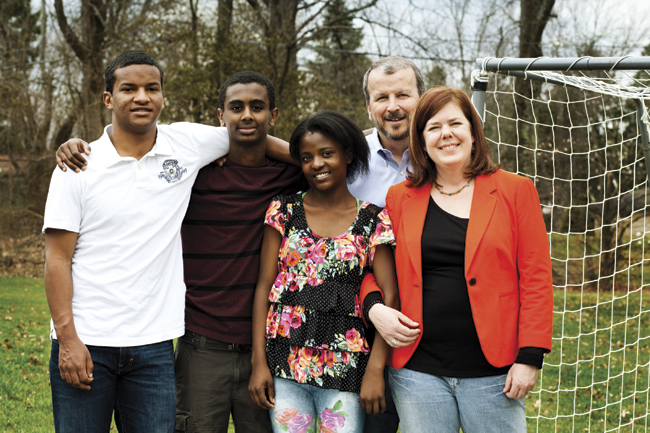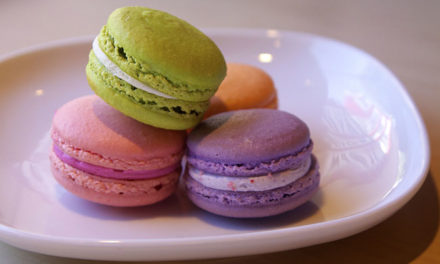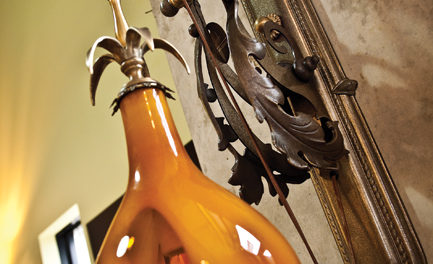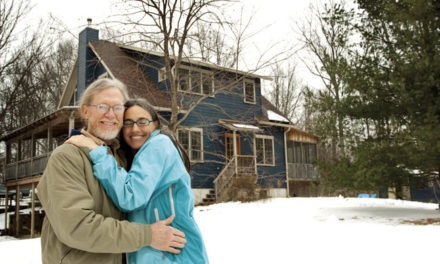BY COLLEEN WELLS
Adopting children of a different race from Third World countries has special challenges and rewards. I know; my husband, Rick, and I adopted two little boys from Ethiopia and a young girl from Haiti.
One of the things Rick and I had in common when we met in 1996 was an interest in Africa. In my early teens, I had been struck by the horrific images of the famine in Ethiopia. As an adult, I wondered how I could make a difference in that country. Rick and I share a deep faith, and after we were married we even considered becoming missionaries. While that wasn’t feasible, adopting was.
To do so, we contacted Cheryl Carter-Shotts at Americans for African Adoptions, an agency located in Indianapolis, where we were living at the time.
We had hoped to adopt a little boy, but as we looked at photographs of toddlers, not one but two caught our attention. The first was a two-year-old little guy named Yakob who had sad, soulful eyes and a distended belly pushing through his white jumper. The other, Ayalkbet, only eight months older, had a shy, charming smile.
Our journey from the dream phase to reality took 14 long months. While enduring endless paperwork, red tape, and delays, there were plenty of things to be anxious about, such as the boys’ health, the impending language barrier, assimilating their diets into ours, and helping them retain their cultural identity. It was comforting when we were able to send a scrapbook introducing ourselves. We wrote words in their native Amharic, identifying us, our dogs, and our home.
The arrival
When it finally came time to pick up the children, Cheryl recommended that we stay home to prepare for their arrival instead of traveling to Ethiopia. We asked my brother, Todd, and a good friend, Kay, to travel for us, knowing they would take good care of the boys.
On January 3, 2001, as the minutes dragged on, Rick and I pressed our faces to the windows inside the Indianapolis airport while we waited for their plane. Tears rolled down my cheeks when Kay and Todd handed us our sons.
When Ayalkbet, then a little over three, and Yakob, then about two and a half, toddled up to our Cape Cod-style home, they started speaking in Amharic to one another and scooping handfuls of snow into their mouths.
Once inside, they were most delighted with the bathroom. They pointed to the toilet, started speaking animatedly, and said, “Shent bet” (the Amharic word for toilet), before using it in unison.
The most poignant moment of that evening came when Rick left to pick up a pizza. Ayalkbet stood at the front door repeating the word “Pop,” while he waited for his return.
Their eyes lit up when Rick opened the pizza box and they saw what was inside. They pointed to the food, and said, “Dabo,” the word for bread in Amharic.
As the boys became Americanized, it was bittersweet to see their native language dissolve, which happened quickly. After only a couple of months, I discovered Ayalkbet, who didn’t yet speak very much English, could sing lyrics. I had been listening to Carole King a lot while driving our van. One day in the grocery store, her song “(You Make Me Feel Like) A Natural Woman” came on, and Ayalkbet started singing along while riding in the cart.
The odd looks
Transracial adoptions bring their own set of complexities, and while we’ve never been confronted in a hostile way, we have experienced some odd looks. Often, though, I believe, people are just curious. Once while vacationing in Santa Fe, New Mexico, Rick took the boys to a swimming pool and a woman stared and asked if she could touch their hair. He didn’t quite know how to respond, as I didn’t the first time a stranger asked in front of the boys if I was their mother.
Rick and I, with Yakob and Ayalkbet, have lived as a family in Bloomington twice now. My husband and I feel it’s a good place to raise our children for the quality of life it offers and because there is diversity.
The years here have been good to us. Our sons, now young teenagers, are healthy, happy, and amazing athletes who still enjoy their fair share of pizza. But the story does not end there.
Our daughter
Over the years, we kept in touch with Cheryl at the adoption agency, and awhile ago we expressed a desire to adopt a girl. That day came after the devastating 2010 earthquake in Haiti. Cheryl became aware of an eight-year-old named Gaelle who had been displaced from her orphanage. She came to the United States under humanitarian parole, an executive action to temporarily allow children in circumstances such as hers to stay in the United States.
Gaelle had suffered much hardship and had been passed around in her young life, and she resisted yet another change when we brought her home shortly after Thanksgiving in 2010. She yearned to have control, so it was only natural that she tested our limits about everything from what she would eat to bedtime to styling her hair. In the first few weeks, she often stormed up to her room, slamming the door. After she cooled down, Rick and I would find her sitting there, her dark eyes flashing and face scrunched, surrounded by a pile of packed suitcases.
Our sons also had adjustments to make. Yakob was suddenly the middle child. Sibling rivalry took center stage, especially in terms of who gets what. I never knew how coveted the last bottle of Gatorade or the last bit of chip dip could be.
There were other challenges, big and small. Although Gaelle spoke English when she arrived here, she was behind her grade level in reading. Through sheer determination, dedicated teachers, and hard work, she caught up. A challenge of another kind is her hair. It requires special products and a level of care different from mine. This is so important to an 11-year-old girl, and often I feel as though I haven’t done her justice.
Gaelle has made great strides in her two and a half years with us. There was a moment last summer that I will never forget. We were on the front porch and she was using sidewalk chalk to draw a picture of flowers and the sun, hearts and grass. When I got up for a closer look, I saw she had also rendered our five faces and, written above it, the word “Family.”
While our children have acquired a shared love of soccer and pepperoni pizza in their years with us, they also share something more special than many American children have. Through a series of serendipitous events, they have become siblings in a family without borders.
















